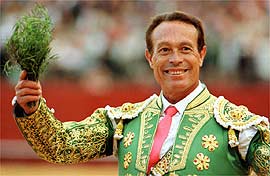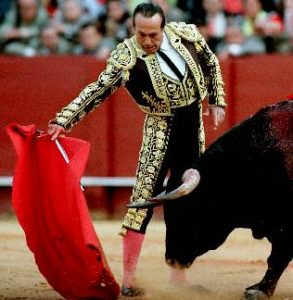LLEGARÁ DE MÉXICO A LA HABANA “CUBA BRAVA”, LA HISTORIA TAURINA DE LA ISLA.
La historia taurina de Cuba, con 20 plazas de toros, llega a La Habana el 7 de julio. «Cuba brava. El toreo en la memoria histórica de Cuba» está dedicada a Curro Romero. Esta celebración se considera un anticipo del intento de hacer regresar a Cuba las corridas de Toros, que ya habían sido autorizadas para ser celebradas en una plaza a ser construida en Isla de Pinos (Isla de la Juventud) en 1973.
El museo de la Casa de México en La Habana abrirá el próximo 7 de julio (San Fermín), y hasta el 30 de agosto, una exposición que recuperará la memoria de la historia de la tauromaquia cubana, que se extiende desde 1492 hasta finales del XIX, con la independencia de la isla.
El que fuera matador de toros mexicano Rodrigo Galguera, ha recopilado durante cuatro años una notable cantidad de objetos, fotos, documentos y fondos bibliográficos que evidencian la larga tradición taurina de este país caribeño, donde se construyeron hasta veinte plazas de toros, entre las que destacó la de Carlos III, de La Habana.
En esos recintos llegaron a actuar las primeras figuras del toreo españolas de finales del XIX, como Guerrita o Luis Mazzantini, Silverio Perez e incluso, por encontrarse allí contratado para varias corridas, murió allí, el 4 de diciembre de 1868 y a los 50 años de edad, el famoso Curro Cúchares, víctima de la «fiebre amarilla».
Galguera, en colaboración con el Gobierno cubano y la embajada de México, explica a EFE que ha conseguido reunir las imágenes, carteles, textos y documentos que atestiguan esta larga historia taurina truncada con la guerra de la independencia cubana y la llegada a la isla de los norteamericanos.
Cuba Brava
Con el título de «Cuba brava. El toreo en la memoria histórica de Cuba», el proyecto, en el que colabora la embajada de México, pretende «fortalecer el vínculo cultural con otros países afectos a los toros y, al mismo tiempo, despertar el interés por la Fiesta en un país que desconoce una historia que fue borrada por un intervencionismo ajeno a la tradición iberoamericana».
Además está prevista la publicación de un libro que amplíe los datos aportados por la exposición, extendiéndose sobre los distintos toreros nacidos en Cuba, como El Cheche, sus distintas plazas y las más de veinte revistas taurinas que reseñaron cada festejo celebrado en la isla, que fue el primer enclave americano donde se lidiaron toros.
La muestra, que incluye pinturas, esculturas, vestidos y trastos de torear, carteles, cabezas de toros y demás objetos relacionados con la lidia, se acompañará de un ciclo de cine taurino, así como de conferencias y cursos dirigidos por Javier Villaseñor, agregado cultural de la embajada mexicana y que tendrán continuidad en varias universidades y escuelas de la isla.
La inauguración de la exposición, que Galguera dedica al diestro Curro Romero, que fue su padrino de alternativa, incluirá el prólogo de un concierto de pasodobles en la Plaza de Armas de La Habana Vieja, tras el que la comitiva, precedida por un alguacilillo, se trasladará en un pasacalles hasta el Museo de la Casa de México habanera.
IT WILL ARRIVE FROM MEXICO TO HAVANA “CUBA BRAVA”, THE CUBAN TAURINE HISTORY.
The taurine history of Cuba, with 20 bullrings, arrives in Havana on July 7. «Cuban Brava”. The bullfighting in the historical memory of Cuba “is dedicated to Curro Romero. This celebration is considered an advance of an attempt to return to Cuba the Bull races, which had already been authorized to be held in a square to be built on Isla de Pinos (Isla de la Juventud) in 1973.
The museum of the House of Mexico in Havana will open next July 7 (San Fermin), and until August 30, an exhibition that will recover the memory of the history of Cuban bullfighting, which extends from 1492 until the end of XIX, with the independence of the island.
The Mexican bullfighter, Rodrigo Galguera, has collected for four years a remarkable number of objects, photos, documents and bibliographic collections that show the long taurine tradition of this Caribbean country, where up to twenty bullrings were built. Said the one of Carlos III, of Havana.
In these places came the first figures of the Spanish bullfighting of the late nineteenth century, such as Guerrita or Luis Mazzantini, Silverio Perez and even, being there contracted for several runs, died there, 4 December 1868 and 50 years of Age, the famous Curro Cúchares, victim of the “yellow fever”.
Galguera, in collaboration with the Cuban government and the Mexican embassy, explains to EFE that he has managed to assemble the images, posters, texts and documents that testify to this long taurine history truncated with the Cuban war of independence and the arrival to the island of The Americans.
Cuba Brava
With the title “Cuba brava. Bullfighting in the historical memory of Cuba, “the project, in which the Mexican Embassy collaborates, aims to” strengthen the cultural link with other countries affected by the bulls and, at the same time, arouse interest in a country Which does not know a history that was erased by an interventionism alien to the Ibero-American tradition. ”
It is also planned to publish a book to expand the data provided by the exhibition, covering the different bullfighters born in Cuba, such as El Cheche, different places and more than twenty taurine magazines that reviewed each celebration held on the island, which Was the first American enclave where they fought bulls.
The exhibition, which includes paintings, sculptures, dresses and bullfights, posters, bullfights and other objects related to the fighting, will be accompanied by a bullfighting film series, as well as lectures and courses led by Javier Villaseñor, cultural attaché Of the Mexican embassy and that will have continuity in several universities and schools of the island.
The inauguration of the exhibition, which Galguera dedicates to the right-hand man Curro Romero, who was his godfather of alternative, will include the prologue of a concert of pasodobles in the Plaza de Armas de La Habana Vieja, after which the entourage, preceded by a alguacilillos, Will be moved in a parade to the Museum of the House of Mexico in Havana.
Agencies/EFE/Various/Internet Photos/Arnoldo Varona/TheCubanHistory.com
THE CUBAN HISTORY, HOLLYWOOD.











